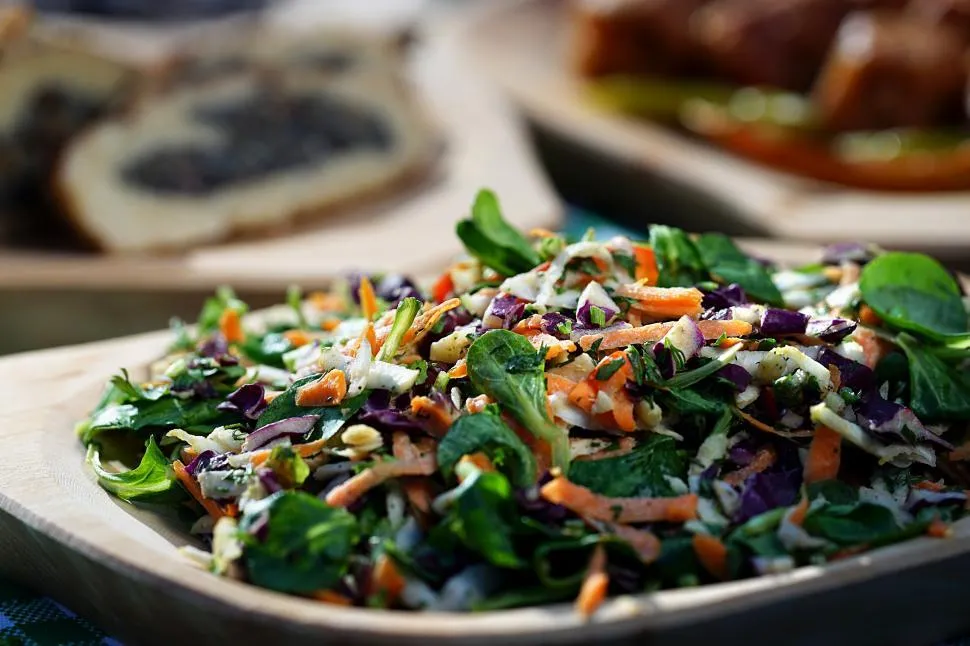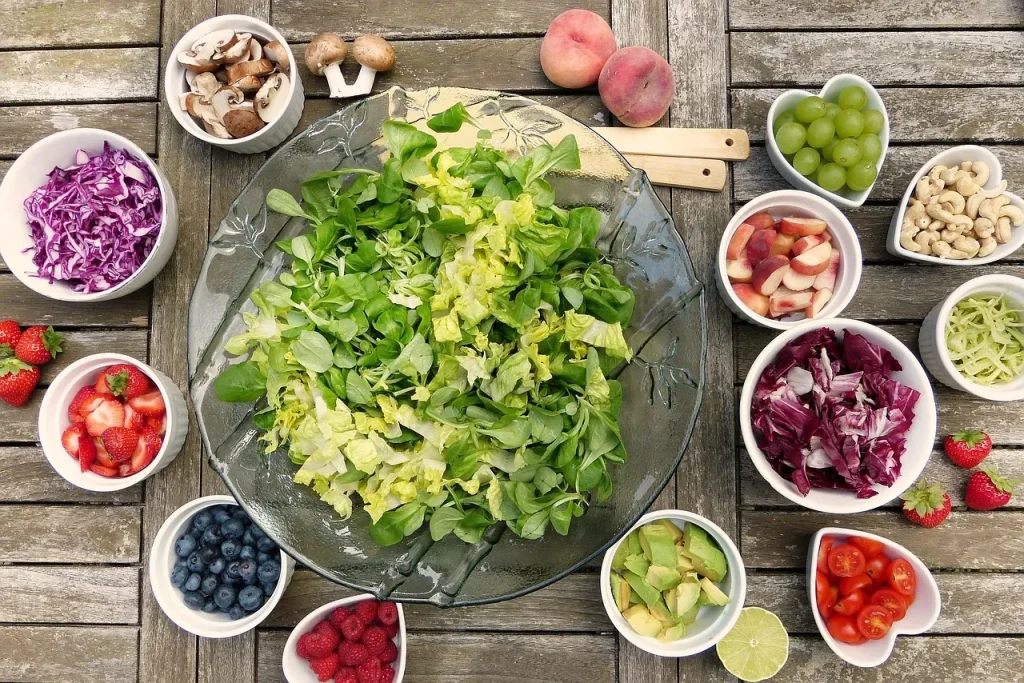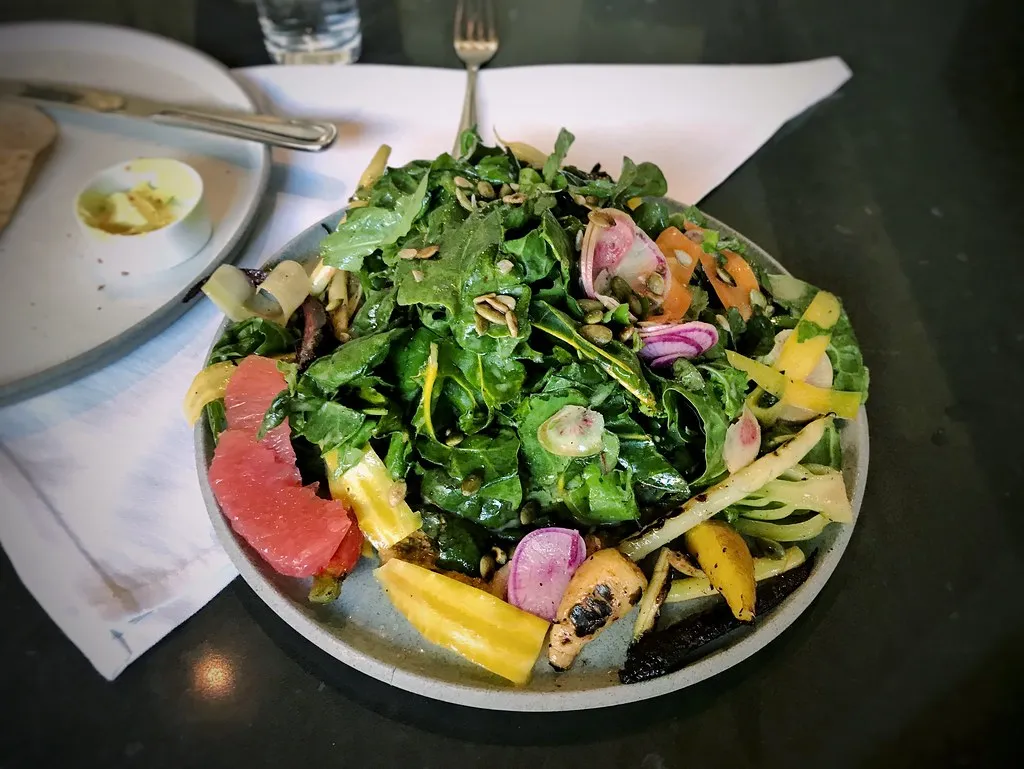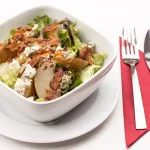The Best Fluffy Pancakes recipe you will fall in love with. Full of tips and tricks to help you make the best pancakes.
Eating healthy doesn’t have to be complicated or time-consuming. One of the easiest ways to nourish your body and boost your energy is by enjoying fresh, nutritious salads. Packed with vitamins, fiber, and wholesome ingredients like leafy greens, protein-rich beans, and healthy fats, salads offer a delicious and versatile meal option that fits perfectly into any lifestyle. Whether you’re looking to lose weight, detox, or simply add more nutrients to your diet, these easy and nutritious salad recipes will inspire you to eat well without sacrificing flavor. Get ready to discover simple salad ideas that are as satisfying as they are good for you!
1. Why Choose Healthy Salads?
Choosing healthy salads as a regular part of your diet comes with numerous benefits that go beyond just eating greens. Salads can be a powerful tool for improving your overall health, supporting weight management, and boosting your energy levels throughout the day.

Benefits of Eating Nutritious Salads
Nutritious salads are packed with essential vitamins and minerals your body needs to function at its best. Leafy greens like kale and spinach are rich in vitamins A, C, and K, as well as antioxidants that help protect your cells from damage. Adding colorful vegetables and fruits increases your intake of fiber, which supports digestion and helps keep you feeling full longer. Plus, incorporating proteins like chickpeas or nuts makes your salad a balanced meal that supports muscle repair and sustained energy.
How Salads Support Clean Eating and Detox
Healthy salads often emphasize whole, unprocessed ingredients that fit perfectly into a clean eating lifestyle. By filling your plate with fresh vegetables, lean proteins, and healthy fats, you reduce your intake of processed foods and harmful additives. Many salad ingredients, like leafy greens and lemon juice, are known for their natural detoxifying properties, helping your liver flush out toxins and improving your body’s overall detox process.
Role of Fiber and Antioxidants in Health
Fiber is a key component of healthy salads that supports gut health, regulates blood sugar levels, and aids in weight management. Antioxidants found in many salad ingredients, including berries, nuts, and green vegetables, fight oxidative stress and inflammation, lowering your risk of chronic diseases such as heart disease and diabetes.
Quick Tips for Making Salads a Daily Habit
Incorporating salads into your daily routine doesn’t have to be hard. Start by prepping ingredients in advance or creating simple recipes that you can mix and match throughout the week. Use a variety of textures and flavors — like crunchy walnuts, creamy avocado, and tangy lemon dressing — to keep salads exciting and satisfying. By making salads a convenient and enjoyable meal choice, you’re more likely to stick with healthy eating habits long-term.
2. Essential Ingredients for Nutritious Salads
Creating a truly nutritious salad starts with choosing the right ingredients. The best salads are those that combine a variety of fresh, wholesome components to deliver a balanced mix of vitamins, minerals, protein, healthy fats, and fiber. Here’s a breakdown of the essential ingredients you should include to maximize both flavor and nutrition:

Fresh Greens: Kale, Spinach, and More
Leafy greens are the foundation of any healthy salad. Dark, leafy varieties like kale, spinach, arugula, and romaine lettuce are packed with nutrients, including vitamin A, vitamin C, vitamin K, and iron. These greens provide fiber that aids digestion and antioxidants that help fight inflammation. Mixing different types of greens not only adds texture and flavor but also ensures you get a broad range of nutrients in every bite.
Protein Boosters: Quinoa, Chickpeas, and Nuts
To turn your salad into a satisfying and complete meal, adding protein is key. Plant-based proteins such as quinoa, chickpeas, lentils, and edamame are excellent choices that keep your salad light yet filling. Nuts like walnuts, almonds, or seeds such as chia and pumpkin seeds add both protein and healthy fats, supporting muscle health and keeping you energized longer. Including protein also helps balance blood sugar levels and prevents mid-afternoon energy slumps.
Healthy Fats: Avocado and Olive Oil
Healthy fats are essential for nutrient absorption and hormone regulation. Avocado is a creamy, nutrient-dense fruit that adds richness and provides monounsaturated fats, which are heart-healthy. Extra virgin olive oil is a staple dressing ingredient that adds flavor while supplying anti-inflammatory compounds and antioxidants. Incorporating these fats in your salad not only enhances taste but also promotes brain health and supports overall well-being.
Flavor Enhancers: Lemon Juice, Greek Yogurt Dressing, and Seeds
A delicious salad needs bright and exciting flavors. Fresh lemon juice or lime juice adds a zesty tang that lifts the entire dish. Greek yogurt-based dressings offer a creamy texture with the benefit of probiotics, which aid gut health. Adding superfoods like chia seeds or flaxseeds introduces a mild crunch and boosts omega-3 fatty acid content. Herbs such as cilantro, parsley, or basil also add vibrant flavors and additional antioxidants to your salad.
3. Easy Salad Recipes to Try Today
Now that you know the benefits of healthy salads and the key ingredients to include, it’s time to dive into some easy and delicious salad recipes you can whip up quickly. These recipes combine fresh, nutritious ingredients to create satisfying meals that support your health goals without requiring hours in the kitchen.

Classic Mediterranean Quinoa Salad
Ingrédients :
- 1 tasse de quinoa cru
- 1 concombre, coupé en petits dés
- 1 tasse de tomates cerises, coupées en deux
- ½ oignon rouge, finement émincé
- ½ tasse d’olives Kalamata dénoyautées, coupées en rondelles
- 100 g de feta émiettée
- 3 cuillères à soupe d’huile d’olive extra vierge
- Le jus d’un citron
- Sel et poivre noir au goût
- Quelques feuilles de menthe ou de persil frais (optionnel)
Instructions :
- Rinse the quinoa under cold water, then cook it according to the package instructions (typically 1 cup of quinoa to 2 cups of water). Let it cool. For an excellent saucepan option, check out this Ninja NeverStick Hard Anodized Saucepan.
- Dans un grand saladier, mélanger le quinoa refroidi avec le concombre, les tomates cerises, l’oignon rouge et les olives.
- Dans un petit bol, fouetter l’huile d’olive, le jus de citron, le sel et le poivre. Verser la vinaigrette sur la salade et mélanger délicatement.
- Ajouter la feta émiettée et les herbes fraîches. Mélanger légèrement et servir frais.
Chickpea and Avocado Detox Salad
Ingrédients :
- 1 avocat mûr, coupé en dés
- 1 boîte (400 g) de pois chiches, rincés et égouttés
- 1 poivron rouge, coupé en petits morceaux
- 2 poignées d’épinards frais
- Le jus d’un citron
- 2 cuillères à soupe d’huile d’olive
- Sel, poivre et une pincée de cumin moulu (optionnel)
Instructions :
- Dans un saladier, combiner les pois chiches, le poivron rouge et les épinards.
- Ajouter l’avocat en dés délicatement pour ne pas l’écraser.
- Arroser avec le jus de citron et l’huile d’olive. Assaisonner avec le sel, le poivre et le cumin si désiré.
- Mélanger doucement pour répartir la vinaigrette et servir immédiatement ou garder au frais.
Spinach and Walnut Superfood Salad
Ingrédients :
- 4 grandes poignées d’épinards frais
- ½ tasse de noix (de préférence noix de Grenoble), grossièrement hachées
- ¼ tasse de canneberges séchées
- 2 cuillères à soupe d’huile d’olive
- 1 cuillère à soupe de vinaigre balsamique
- 1 cuillère à café de miel ou sirop d’érable (optionnel)
- Sel et poivre au goût
- Optionnel : 2 cuillères à soupe de yaourt grec nature pour une version crémeuse
Instructions :
- Dans un grand saladier, déposer les épinards, les noix et les canneberges séchées.
- Dans un petit bol, mélanger l’huile d’olive, le vinaigre balsamique, le miel, le sel et le poivre.
- Verser la vinaigrette sur la salade et mélanger délicatement.
- Pour une version plus crémeuse, incorporer du yaourt grec nature avant de servir.
Simple Kale and Lemon Dressing Salad
Ingrédients :
- 1 bouquet de kale (chou frisé), feuilles lavées et coupées en morceaux
- Le jus d’un citron
- 2 cuillères à soupe d’huile d’olive extra vierge
- Sel de mer et poivre au goût
- 2 cuillères à soupe de graines de tournesol ou d’amandes effilées (pour le croquant)
Instructions :
- Placer les morceaux de kale dans un saladier. Masser doucement les feuilles avec les mains pendant 2-3 minutes jusqu’à ce qu’elles deviennent plus tendres et légèrement foncées.
- Arroser le kale avec le jus de citron, l’huile d’olive, le sel et le poivre. Mélanger bien pour enrober toutes les feuilles.
- Ajouter les graines de tournesol ou les amandes effilées pour apporter du croquant.
- Servir immédiatement ou conserver au frais dans un contenant hermétique.
4. How to Prepare and Store Salads for Meal Prep
Meal prepping salads is a smart way to save time, eat healthy throughout the week, and avoid last-minute unhealthy choices. But preparing and storing salads properly is key to keeping your greens fresh, your ingredients crisp, and your dressings flavorful. Here’s how to master salad meal prep like a pro:
Choosing the Best Ingredients for Freshness
Start with fresh, high-quality produce. Look for crisp greens like romaine or kale that aren’t wilted or discolored. Pick vegetables and fruits that are firm and free from bruises. Choosing ingredients that have a longer shelf life, such as carrots, cucumbers, and cabbage, can help your salad stay fresh longer. Using pre-washed and pre-cut vegetables can speed up prep time, but always double-check for freshness.
Tips for Keeping Greens Crisp and Fresh
One of the biggest challenges with salad prep is keeping greens from getting soggy or wilted. A helpful trick is to wash and thoroughly dry your greens using a salad spinner or clean kitchen towels. Store the greens wrapped loosely in a paper towel inside an airtight container or resealable bag—this absorbs excess moisture and prevents wilting. Avoid adding dressings or wet ingredients until you’re ready to eat to maintain crispness.
Best Containers and Dressings for Storage
Using the right containers can make all the difference. Glass containers with tight-fitting lids are ideal because they prevent air from spoiling your salad while being easy to clean and reuse. Mason jars are popular for layered salads, keeping wet ingredients like dressings and tomatoes separate from the greens at the bottom until it’s time to eat. For dressings, store them separately in small containers or bottles to keep salads fresh and allow you to control the amount added.
Making Salad Prep Quick and Efficient
To save time, dedicate one day a week for salad prep. Chop your vegetables, cook grains like quinoa or farro, and prepare protein additions like grilled chicken or chickpeas ahead of time. Portion ingredients into containers based on your meal plan. Consider making versatile dressings that can be used on different salads throughout the week. Having everything ready to go means you can assemble a healthy, delicious salad in minutes, even on your busiest days.
5. Salad Dressing Ideas for Extra Flavor and Nutrition
A great salad isn’t just about fresh ingredients — the dressing plays a crucial role in bringing all the flavors together and enhancing the nutritional value. Choosing healthy, homemade dressings over store-bought ones can significantly reduce added sugars, unhealthy fats, and preservatives. Here are some delicious and nutritious salad dressing ideas that you can easily prepare at home to elevate your salads:
Healthy Olive Oil and Lemon Dressing
Simple yet powerful, a classic olive oil and lemon dressing is a staple for many nutritious salads. Extra virgin olive oil is rich in heart-healthy monounsaturated fats and antioxidants, while fresh lemon juice adds a bright, tangy flavor and a boost of vitamin C. Whisk together olive oil, lemon juice, a pinch of sea salt, and freshly cracked black pepper for a quick dressing that complements almost any salad.
Creamy Greek Yogurt-Based Dressings
For those who love creamy textures but want to avoid heavy, calorie-laden dressings, Greek yogurt-based options are ideal. Greek yogurt is packed with protein and probiotics, which promote gut health. Mix plain Greek yogurt with ingredients like garlic, fresh herbs (dill, parsley, or chives), lemon juice, and a drizzle of olive oil for a tangy, creamy dressing that adds richness without the guilt.
Low-Calorie Vinegar and Herb Dressings
Vinegar-based dressings offer a zesty punch with minimal calories. Apple cider vinegar, balsamic vinegar, or red wine vinegar each bring unique flavors and health benefits, including improved digestion and blood sugar regulation. Combine your choice of vinegar with olive oil, a touch of honey or maple syrup for sweetness, minced garlic, and fresh herbs such as basil, oregano, or thyme for a vibrant dressing that brightens up any bowl.
Adding Superfoods Like Chia Seeds and Turmeric
Boost your dressings’ nutrition by incorporating superfoods like chia seeds, turmeric, or ground flaxseeds. Chia seeds add a slight crunch and are a great source of omega-3 fatty acids and fiber. Turmeric brings anti-inflammatory properties and a warm, earthy flavor. You can blend these ingredients into your dressings or sprinkle them on top of your salad for an extra health boost and exciting texture.
For more delicious and healthy options, check out these Vegan Salad Dressings: Homemade Recipes to add extra flavor and nutrition to your salads.






[…] As a Party Appetizer: Place them on a wooden serving board alongside ranch dressing, chipotle mayo, or BBQ sauce for dipping. For a fresh and balanced spread, pair them with one of these easy and nutritious salad recipes. […]